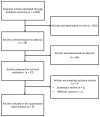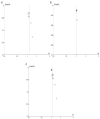Dietary Inflammatory Index and Colorectal Cancer Risk-A Meta-Analysis
- PMID: 28930191
- PMCID: PMC5622803
- DOI: 10.3390/nu9091043
Dietary Inflammatory Index and Colorectal Cancer Risk-A Meta-Analysis
Abstract
Diet and chronic inflammation of the colon have been suggested to be risk factors in the development of colorectal cancer (CRC). The possible link between inflammatory potential of diet, measured through the Dietary Inflammatory Index (DII®), and CRC has been investigated in several populations across the world. The aim of this study was to conduct a meta-analysis on studies exploring this association. Data from nine studies were eligible, of which five were case-control and four were cohort studies. Results from meta-analysis showed a positive association between increasing DII scores, indicating a pro-inflammatory diet, and CRC. Individuals in the highest versus the lowest (reference) DII category showed an overall 40% increased risk of CRC with moderate evidence of heterogeneity [relative risk (RR) = 1.40, 95% confidence interval (CI): 1.26, 1.55; I² = 69%, p < 0.001]. When analyzed as a continuous variable, results showed an increased risk of CRC of 7% for a 1-point increase in the DII score. Results remained unchanged when analyses were restricted to the four prospective studies. Results of our meta-analysis support the importance of adopting a healthier anti-inflammatory diet in preventing CRC. These results further substantiate the utility of DII as tool to characterize the inflammatory potential of diet and to predict CRC.
Keywords: colorectal cancer; cytokines; diet; dietary inflammatory index; epidemiology; inflammation; meta-analysis; nutrition.
Conflict of interest statement
Disclosure: J.R.H. owns controlling interest in Connecting Health Innovations LLC (CHI), a company planning to license the right to his invention of the dietary inflammatory index (DII) from the University of South Carolina in order to develop computer and smart phone applications for patient counseling and dietary intervention in clinical settings. M.D.W. and N.S. are employees of CHI.
Figures








Similar articles
-
Dietary Inflammatory Index and Cardiovascular Risk and Mortality-A Meta-Analysis.Nutrients. 2018 Feb 12;10(2):200. doi: 10.3390/nu10020200. Nutrients. 2018. PMID: 29439509 Free PMC article. Review.
-
Dietary inflammatory index and odds of colorectal cancer in a case-control study from Jordan.Appl Physiol Nutr Metab. 2017 Jul;42(7):744-749. doi: 10.1139/apnm-2017-0035. Epub 2017 Feb 22. Appl Physiol Nutr Metab. 2017. PMID: 28226219
-
Meta-analysis of the association between the inflammatory potential of diet and colorectal cancer risk.Oncotarget. 2017 Jul 14;8(35):59592-59600. doi: 10.18632/oncotarget.19233. eCollection 2017 Aug 29. Oncotarget. 2017. PMID: 28938662 Free PMC article.
-
Dietary Inflammatory Index, Dietary Non-Enzymatic Antioxidant Capacity, and Colorectal and Breast Cancer Risk (MCC-Spain Study).Nutrients. 2019 Jun 21;11(6):1406. doi: 10.3390/nu11061406. Nutrients. 2019. PMID: 31234427 Free PMC article.
-
Meta-Analysis of the Association between Dietary Inflammatory Index (DII) and Colorectal Cancer.Nutrients. 2022 Apr 8;14(8):1555. doi: 10.3390/nu14081555. Nutrients. 2022. PMID: 35458117 Free PMC article. Review.
Cited by
-
Development of a Japanese Healthy Diet Index: The Fukushima Health Management Survey 2011.Int J Environ Res Public Health. 2022 Nov 11;19(22):14858. doi: 10.3390/ijerph192214858. Int J Environ Res Public Health. 2022. PMID: 36429593 Free PMC article.
-
Chinese Dietary Indices and Glioma: New Insights of a Case-Control Study in the Chinese Population.Nutrients. 2023 Aug 17;15(16):3602. doi: 10.3390/nu15163602. Nutrients. 2023. PMID: 37630792 Free PMC article.
-
A pro-inflammatory diet increases the likelihood of obesity and overweight in adolescent boys: a case-control study.Diabetol Metab Syndr. 2020 Apr 7;12:29. doi: 10.1186/s13098-020-00536-0. eCollection 2020. Diabetol Metab Syndr. 2020. PMID: 32292493 Free PMC article.
-
Dietary Inflammatory Index and Risk of Asthenozoospermia: A Hospital-Based Case-Controlled Study in China.Front Nutr. 2021 Jul 29;8:706869. doi: 10.3389/fnut.2021.706869. eCollection 2021. Front Nutr. 2021. PMID: 34395499 Free PMC article.
-
The association of dietary inflammatory potential with skeletal muscle strength, mass, and sarcopenia: a meta-analysis.Front Nutr. 2023 May 15;10:1100918. doi: 10.3389/fnut.2023.1100918. eCollection 2023. Front Nutr. 2023. PMID: 37255936 Free PMC article.
References
-
- IARC Globocan 2012: Estimated Cancer Incidence, Mortality and Prevalance Worldwide 2012. [(accessed on 18 September 2017)]; Available online: http://globocan.iarc.fr/Pages/fact_sheets_cancer.aspx.
-
- Vogel V.G., McPherson R.S. Dietary epidemiology of colon cancer. Hematol. Oncol. Clin. N. Am. 1989;3:35–63. - PubMed
Publication types
MeSH terms
Grants and funding
LinkOut - more resources
Full Text Sources
Other Literature Sources
Medical

